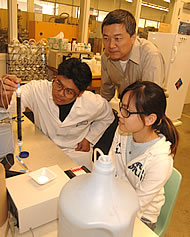Engineering Professor Dives Into Study for Disinfecting Water
Civil and environmental engineering professor examines various water disinfection technologies and evaluate their effectiveness, chemical residuals, toxicity, stability and implementability of each technology.
May 18, 2006
By LINDA CAPLETTE
Nowadays it's hard to spot an individual who isn't carrying a bottle of drinking water. Sporting events, going to classes, attending workshops — the importance of eight glasses of water a day appears to have hit home.
But how safe is the water we drink? Despite the Clean Water Act of 1972 and the Safe Drinking Water Act of 1974, there are still occasional stories of contamination and concerns for the quality of water.
Jeff Kuo, professor of civil and environmental engineering, under a $20,000 contract from the Water Environment Research Foundation, is working on a comparison study of water and wastewater disinfection alternatives.
The research is being done in collaboration with the Los Angeles County Sanitation Districts and Kennedy/Jenks Consultants.
"There are many treatment options to improve water quality, and the choice often depends on the ultimate use of the water — drinking, reuse, or released to a body of water — and the types of contaminants that need to be removed," said Kuo, who has studied water quality for 20 years.
The most common method of disinfecting water in the United States is chlorination. However, "water disinfection using ultraviolet light is gaining in popularity," he added.
Currently, there is no single, comprehensive resource that environmental engineers, water departments and municipal water treatment facilities can refer to when trying to decide which disinfection method to use.
Kuo says his goal is "to produce a single document that will compare the cost, pros and cons of each type of disinfection method." The document would serve as a tool for engineers, regulators, state and local agencies involved with water/wastewater disinfection.
Kuo will evaluate effectiveness, chemical residuals, toxicity, stability and implementability of each technology.
As part of his research, the engineer will consider variable factors such as contact time and concentration required to kill pathogens, suitability for specific applications, and possible environmental consequence when the disinfected water is released to its final destination.
Which disinfection method is best? Kuo says there is no single answer.
"It depends on what the water will be used for, what pathogens need to be removed and what disinfection byproducts may be formed, before the water is released to its final destination."
«
back to News Front
|

Jeff Kuo, professor of civil and environmental engineering, oversees Vladimir Carino and Linda Liu as they perform a process that removes pollutant from water using nanoparticles.
|
|